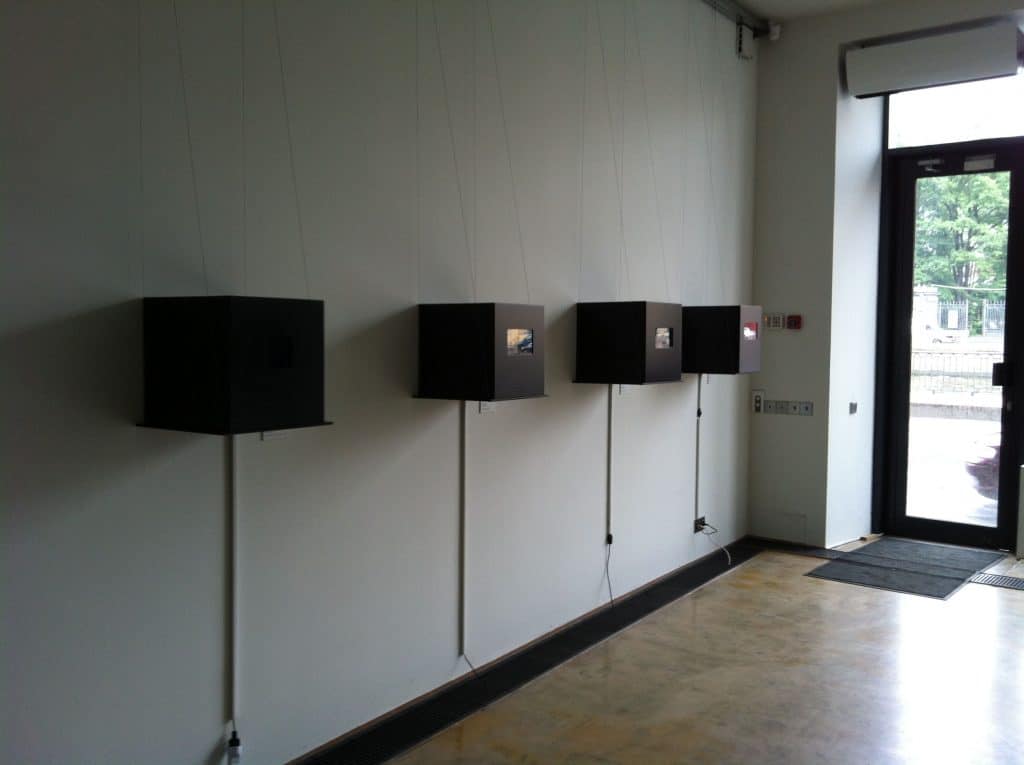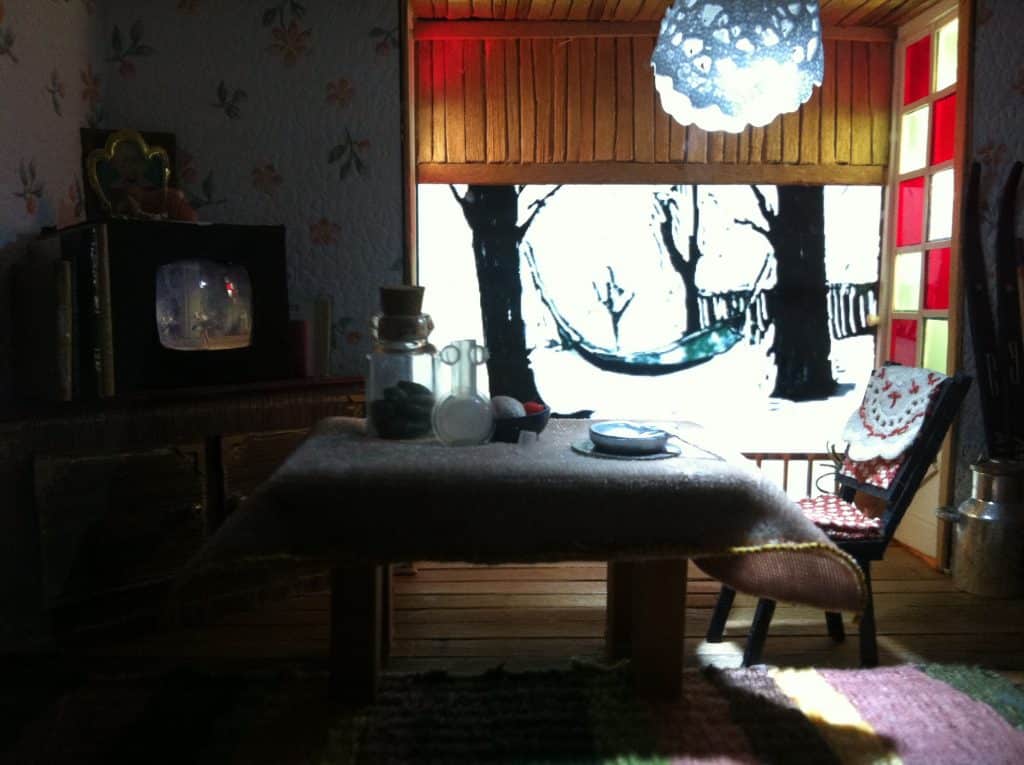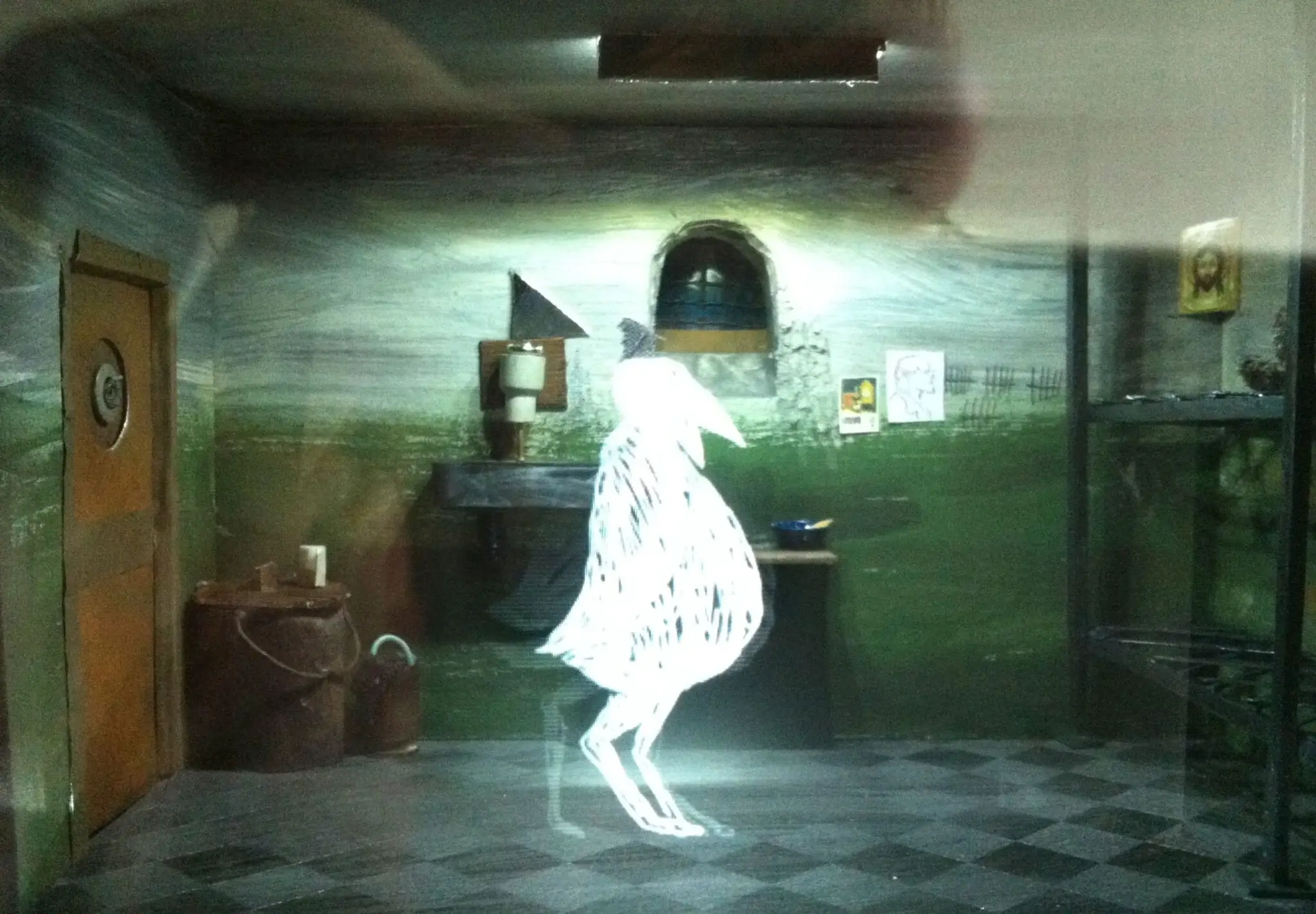When you find yourself in front of the Marina Gisich Gallery on Reki Fontaki, it’s difficult at first to tell if you’ve found yourself at one of St. Petersburg’s most significant contemporary art centers, or at a building undergoing major electrical work.
The space is currently hosting Marina Aleexeva’s “Lifeboxes,” which features shadowboxes of painstakingly fabricated interior environments and light boxes complete with surrealistic video projections of the spaces’ lively inhabitants. The current installation features rows of identical black boxes hanging humbly on the white, unembellished walls of a dimly lit gallery, each one plugged into an electrical outlet by a plain black cord, more resemblent of a transformer or circuit box than a carefully-constructed habitat. Given the simplicity of the space, the viewer is startled when, upon walking through the gallery doors, a cacophony of music, voices, and bizarre sound effects issues forth from the opaque terrarium walls. Indeed, these ambiguous cubes are not lifeless electrical components, but self-contained miniature environments.

Founded in 2000, the Marina Gisich Gallery specializes in representing Petersburg artists who have already won acclaim, and Marina Alexeeva is no exception. Considered by many to be at the forefront of Russian contemporary art, she’s been steadily at work perfecting her Lifeboxes for about five years now, and the refinement of her technique is presented before our very eyes on the walls of the Marina Gisich Gallery. Developing from shadowboxes reminiscent of the work of Joseph Cornell to complex interactions and collaborations between the diminutive homesteads of Alexeeva and the video projections of her husband Boris Kazakov, we are granted the rare opportunity to map the trajectory of Alexeeva’s artistic development in a single space. Moreover, we are dually fortunate to witness a unique collaboration between Alexeeva and Kazakov in the process.
The first row of “Lifeboxes” is of the animated variety. The residents of her domiciles romp through their tiny spaces, transforming and interacting with each other. Each environment is fastidiously detailed. Bedrooms, kitchens, prisons, offices, museum halls, a plethora of other intimate interior spaces are miniaturized and accessorized with incredible precision. In one such work, “Prison”, from 2011, a figure moves about and metamorphosizes within the walls of a meticulously rendered cell. At one moment the inmate is a man, in the next he is a bird, and in the minutes thereafter his form undulates and rearranges into a solider, an animal, and a number of shapeless amalgamations inbetween phases. Alexeeva’s replica of a prison is complete with an icon in the corner and landscape painted longingly on the dingy prison walls, possibly inviting us to consider the life of an inmate trapped in his concrete quarters, and perhaps peripherally commenting on controversies surrounding Russian correctional facilities.

Each projection box is also complete with its own soundtrack. Not only do we observe as Aleexeva’s inhabitants entertain guests, make love, and transform from figures into formlessness, but we are also privy to the din of their lives in their tiny abodes. Scenes of domestic trepidation, doctors and patients, and musicians arguing with friends are at once playful surrealistic frolics, and simultaneously suggestions of larger issues lurking beneath the surface of her work.
Aleexeva’s artist statement, which hangs near the front of the exhibition (and is available in both English and Russian) professes an interest in commodity culture, global politics, gender roles, and many other salient issues in our contemporary lives. Mentioning a fascination with the role of such retail entities as IKEA, an interest in Soviet era kitcshe, and a preoccupation with “the notion of personhood and the role of the individual are becoming ever more indeterminate,” Alexeeva’s Lifeboxes represent a diverse bouquet of biospheres tacking an abundance of critical issues. Indeed, after viewing “Lifeboxes,” one cannot help but ruminate on the role played by our environments in our lives, and the larger influence it exerts on society. We’re tempted to wonder whether our reliance upon the artifacts of our daily lives to define and shape our existence is perhaps misplaced, or if our imaginations, dreams, and fears are the real substance that punctuates and sculpts our lives. Alexeeva invites us to consider these diverse and difficult topics piecemeal: instead of presenting the viewer with an overwhelming environmental experience, we are instead allowed to gaze into a microcosm, a facsimile of our lives presented to us in fantastic miniaturized detail.
The Marina Gisich Gallery
121 Reki Fontaki nab.
Monday thru Friday 11:00-19:00;
Closed Saturday and Sunday.
Free and open to all.
Website






